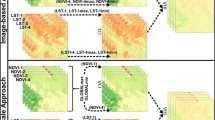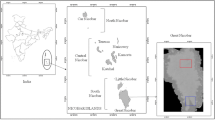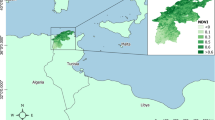Abstract
Normalized difference vegetation index (NDVI) is the most widely used factor in the growth status of vegetation, and improving the prediction of NDVI is crucial to the advancement of regional ecology. In this study, a novel NDVI forecasting model was developed by combining time series decomposition (TSD), convolutional neural networks (CNN) and long short-term memory (LSTM). Two forecasting models of climatic factors and four NDVI forecasting models were developed to validate the performance of the TSD-CNN-LSTM model and investigate the NDVI's response to climatic factors. Results indicate that the TSD-CNN-LSTM model has the best prediction performance across all series, with the RMSE, NSE and MAE of NDVI prediction being 0.0573, 0.9617 and 0.0447, respectively. Furthermore, the TP-N (Temperature & Precipitation-NDVI) model has a greater effect than the T-N (Temperature-NDVI) and P-N (Precipitation-NDVI) models, according to the climatic factors-based NDVI forecasting model. Based on the results of the correlation analysis, it can be concluded that changes in NDVI are driven by a combination of temperature and precipitation, with temperature playing the most significant role. The preceding findings serve as a helpful reference and guide for studying vegetation growth in response to climate changes.






Similar content being viewed by others
Availability of Data and Materials
The data used to support the findings of this study are available from the corresponding author upon request.
Abbreviations
- N DVI :
-
Normalized difference vegetation index
- TSD :
-
Time series decomposition
- C NN :
-
Convolutional neural network
- L STM :
-
Long short-term memory
- ARIMA :
-
Autoregressive integrated moving average
- R /S :
-
Rescaled range analysis
- T CL :
-
TSD-CNN-LSTM
- T C :
-
TSD-CNN
- T L :
-
TSD-LSTM
- T-T :
-
Temperature-Temperature
- T-N :
-
Temperature-NDVI
- P-N :
-
Precipitation-NDVI
- TP-N :
-
Temperature & Precipitation-NDVI.
References
Aghelpour P, Mohammadi B, Biazar SM (2019) Long-term monthly average temperature forecasting in some climate types of Iran, using the models SARIMA, SVR, and SVR-FA. Theor Appl Climatol 138(3–4):1471–1480. https://doi.org/10.1007/s00704-019-02905-w
Alamdarloo EH, Manesh MB, Khosravi H (2018) Probability assessment of vegetation vulnerability to drought based on remote sensing data. Environ Monit Assess 190:702. https://doi.org/10.1007/s10661-018-7089-1
Bandara K, Bergmeir C, Smyl S (2020) Forecasting across time series databases using recurrent neural networks on groups of similar series: A clustering approach. Expert Syst Appl 140. https://doi.org/10.1016/j.eswa.2019.112896
Barzegar R, Aalami MT, Adamowski J (2020) Short-term water quality variable prediction using a hybrid CNN–LSTM deep learning model. Stoch Env Res Risk A 34:415–433. https://doi.org/10.1007/s00477-020-01776-2
Bianchi E, Villalba R, Solarte A (2019) NDVI spatio-temporal patterns and climatic controls over northern Patagonia. Ecosystems 23(1):84–97. https://doi.org/10.1007/s10021-019-00389-3
Cañón J, Domínguez F, Valdes JB (2011) Vegetation responses to precipitation and temperature: a spatiotemporal analysis of ecoregions in the Colorado River Basin. Int J Remote Sens 32(20):5665–5687. https://doi.org/10.1080/01431161.2010.507259
Cui CL, Zhang W, Hong ZM, Meng LK (2020) Forecasting NDVI in multiple complex areas using neural network techniques combined feature engineering. Int J Digital Earth 13(12):1733–1749. https://doi.org/10.1080/17538947.2020.1808718
Cui L, Shi J (2010) Temporal and spatial response of vegetation NDVI to temperature and precipitation in eastern China. J Geogr Sci 20(2):163–176. https://doi.org/10.1007/s11442-010-0163-4
Eamus D, Fronend R, Loomes R, Hose G, Brad M (2006) A functional methodology for determining the groundwater regime needed to maintain the health of groundwater-dependent vegetation. Aust J Bot 54(2):97–114. https://doi.org/10.1071/BT05031
Findley DF, Monsell BC, Bell WR, Otto MC, Chen B-C (1998) New capabilities and methods of the X-12-ARIMA seasonal-adjustment program. J Bus Econ Stat 16(2):127–152
Guo HY, Chen QX, Xia Q, Kang CQ, Zhang X (2018) A monthly electricity consumption forecasting method based on vector error correction model and self-adaptive screening method. Int J Elec Power 95:427–439. https://doi.org/10.1016/j.ijepes.2017.09.011
He WP, Liu QQ, Jiang YD, Lu Y (2015) Comparison of performance between rescaled range analysis and rescaled variance analysis in detecting abrupt dynamic change. Chin Phys B 24(4):04920510. https://doi.org/10.1088/1674-1056/24/4/049205
Hensman P, Masko D (2015) The impact of imbalanced training data for convolutional neural networks. Degree Project in Computer Science, KTH Royal Institute of Technology, KTH Royal Institute of Technology
Herrmann SM, Anyamba A, Tucker CJ (2005) Recent trends in vegetation dynamics in the African Sahel and their relationship to climate. Glob Environ Change 15(4):394–404. https://doi.org/10.1016/j.gloenvcha.2005.08.004
Hou L (2021) Impact of COVID-19 on latent emissiveness of residents in China: Based on the X-12-ARIMA additive seasonal adjustment model. J Comput Methods Sci Eng 21:1591–1604. https://doi.org/10.3233/JCM-215473
Hu H, Zhang JF, Li T (2021) A novel hybrid decompose-ensemble strategy with a VMD-BPNN approach for daily streamflow estimating. Water Resour Manag 35:5119–5138. https://doi.org/10.1007/s11269-021-02990-5
Huang SZ, Ming B, Huang Q et al (2017) A case study on a combination NDVI forecasting model based on the entropy weight method. Water Resour Manag 31:3667–3681. https://doi.org/10.1007/s11269-017-1692-8
Jaber SM (2019) On the relationship between normalized difference vegetation index and land surface temperature: MODIS-based analysis in a semi-arid to arid environment. Geocarto Int 36(10):1117–1135. https://doi.org/10.1080/10106049.2019.1633421
Jiao F, Huang L, Song RJ, Huang HF (2021) An improved STL-LSTM model for daily bus passenger flow prediction during the COVID-19 pandemic. Sensors-Basel 21(17):5950. https://doi.org/10.3390/s21175950
Jong R, Verbesselt J, Schaepman ME, Bruin S (2012) Trend changes in global greening and browning: contribution of short-term trends to longer-term change. Glob Change Biol 18(2):642–655. https://doi.org/10.1111/j.1365-2486.2011.02578.x
Kalinin VV, Berg DB, Nazarova YY, Parusheva SS, Dolganov AN (2018) R/S-analysis of cash-flow: Cases of business eco community and separate enterprise. Aip Conf Proc 2040:050015. https://doi.org/10.1063/1.5079113
Kogan FN (1990) Remote sensing of weather impacts on vegetation in non-homogeneous areas. Int J Remote Sens 11(8):1404–1419. https://doi.org/10.1080/01431169008955102
Kuila S, Dhanda N, Joardar S (2022) ECG signal classification and arrhythmia detection using ELM-RNN. Multimed Tools Appl. https://doi.org/10.1007/s11042-022-11957-6
Lamchin M, Lee W-K, Jeon SW, WangSW LCH, Song C, Sung MJ (2018) Long-term trend and correlation between vegetation greenness and climate variables in Asia based on satellite data. Sci Total Environ 618:1089–1095. https://doi.org/10.1016/j.scitotenv.2017.09.145
Liu S, Ji H, Wang MC (2020) Nonpooling convolutional neural network forecasting for seasonal time series with trends. Ieee T Neur Net Lear 31(8):2879–2888. https://doi.org/10.1109/Tnnls.2019.2934110
Liu YX, Wang YL, Du YY, Zhao MY, Peng J (2016) The application of polynomial analyses to detect global vegetation dynamics during 1982–2012. Int J Remote Sens 37(7):1568–1584. https://doi.org/10.1080/01431161.2016.1142688
Malik SA, Parah SA, Malik BA (2022) Power line noise and baseline wander removal from ECG signals using empirical mode decomposition and lifting wavelet transform technique. Health Technol-Ger. https://doi.org/10.1007/s12553-022-00662-x
Na R, Na L, Du H, He HS, Shan Y, Zong S, Huang L, Yang Y, Wu Z (2021) Vegetation greenness variations and response to climate change in the arid and semi-arid transition zone of the mongo-lian plateau during 1982–2015. Remote Sens 13(20). https://doi.org/10.3390/rs13204066
Ni LL, Wang D, Singh VP, Wu JF, Wang YK, Tao YW (2020) Streamflow and rainfall forecasting by two long short-term memory-based models. J Hydrol 583:124296. https://doi.org/10.1016/j.jhydrol.2019.124296
Niazkar M, Zakwan M (2021) Application of MGGP, ANN, MHBMO, GRG, and linear regression for developing daily sediment rating curves. Math Probl Eng. https://doi.org/10.1155/2021/8574063
Nikolopoulos D, Moustris K, Petraki E, Cantzos D (2021) Long-memory traces in PM10 time series in Athens, Greece: investigation through DFA and R/S analysis. Meteorol Atmos Phys 133(2):261–279. https://doi.org/10.1007/s00703-020-00744-3
Panwar VS, Pandey A, Hasan ME (2021) Generalised regression neural network (Grnn) architecture-based motion planning and control of an e-puck robot in V-Rep software platform. Acta Mech Autom 15(4):209–214. https://doi.org/10.2478/ama-2021-0027
Parizi E, Hosseini SM, Ataie-Ashtiani B, Simmons CT (2020) Normalized difference vegetation index as the dominant predicting factor of groundwater recharge in phreatic aquifers: case studies across Iran. Sci Rep 10(1):17473. https://doi.org/10.1038/s41598-020-74561-4
Parviz L (2020) Comparative evaluation of hybrid SARIMA and machine learning techniques based on time varying and decomposition of precipitation time series. J Agr Sci Tech-Iran 22(2):563–578
Pei FS, Wu CJ, Liu XP, Li X, Yang KQ, Zhou Y, Wang K, Xu L, Xia GR (2018) Monitoring the vegetation activity in China using vegetation health indices. Agr Forest Meteorol 248:215–227. https://doi.org/10.1016/j.agrformet.2017.10.001
Pepin N, Bradley RS, Diaz HF et al (2015) Elevation-dependent warming in mountainregions of the world. Nat Clim Change 5(5):424–430. https://doi.org/10.1038/NCLIMATE2563
Pérez-Alarcón A, Garcia-Cortes D, Fernández-Alvarez JC, Martínez-González Y (2022) Improving monthly rainfall forecast in a watershed by combining neural networks and autoregressive models. Environ Process 9:53. https://doi.org/10.1007/s40710-022-00602-x
Pfeffermann D, Sverchkov M (2014) Estimation of mean squared error of X-11-ARIMA and other estimators of time series components. J Off Stat 30(4):811–838. https://doi.org/10.2478/Jos-2014-0049
Qayyum A, Khan MKAA, Benzinou A, Mazher M, Ramasamy M, Aramugam K, Deisy C, Sridevi S, Suresh M (2022) An efficient 1DCNN-LSTM deep learning model for assessment and classification of fMRI-based autism spectrum disorder. Lect Note Data Eng 96:1039–1048. https://doi.org/10.1007/978-981-16-7167-8_77
Qiao YH, Wang Y, Ma CX, Yang J (2021) Short-term traffic flow prediction based on 1DCNN-LSTM neural network structure. Mod Phys Lett B 35(2):2150042. https://doi.org/10.1142/S0217984921500421
Rajesh M, Anishka S, Viksit PS, Arohi S, Rehana S (2022) Improving short-range reservoir inflow forecasts with machine learning model combination. Waetr Resour Manag. https://doi.org/10.1007/s11269-022-03356-1
Roy DK (2021) Long short-term memory networks to predict one-step ahead reference evapotranspiration in a subtropical climatic zone. Environ Process 8:911–941. https://doi.org/10.1007/s40710-021-00512-4
Su T, Feng TC, Huang BH, Han ZX, Qian ZH, Feng GL, Hou W (2021) Trend, seasonal, and irregular variations in regional actual evapotranspiration over china: A multi-dataset analysis. Front Phys 9(718771). https://doi.org/10.3389/fphy.2021.718771
Tran HT, Campbell JB, Tran TD, Tran HT (2017) Monitoring drought vulnerability using multispectral indices observed from sequential remote sensing (case study: Tuy Phong, Binh Thuan, Vietnam). Gisci Remote Sens 54(1):167–184. https://doi.org/10.1080/15481603.2017.1287838
Tulensalo J, Seppanen J, Ilin A (2020) An LSTM model for power grid loss prediction. Electr Pow Syst Res 189:106823. https://doi.org/10.1016/j.epsr.2020.106823
Wang S, Huang GH, Huang W et al (2015) A polynomial chaos ensemble hydrologic prediction system for efficient parameter inference and robust uncertainty assessment. J Hydrol 529:1129–1146. https://doi.org/10.1016/j.jhydrol.2015.10.021
Wei M, You XY (2022) Monthly rainfall forecasting by a hybrid neural network of discrete wavelet transformation and deep learning. Water Resour Manag 36:4003–4018. https://doi.org/10.1007/s11269-022-03218-w
Wu TS, Fu HP, Feng F, Bai HM (2019) A new approach to predict normalized difference vegetation index using time-delay neural network in the arid and semi-arid grassland. Int J Remote Sens 1–14. https://doi.org/10.1080/01431161.2019.1624870
Yan W (2012) Toward automatic time-series forecasting using neural networks. IEEE Trans Neural Netw Learn Syst 23(7):1028–1039. https://doi.org/10.1109/TNNLS.2012.2198074
Zakwan M (2019) Comparative analysis of the novel infiltration model with other infiltration models. Water Environ J 33(4):620–632. https://doi.org/10.1111/wej.12435
Zarei AR, Mahmoudi MR (2020a) Ability assessment of the stationary and cyclostationary time series models to predict drought indices. Water Resour Manag 34(15):5009–5029. https://doi.org/10.1007/s11269-020-02710-5
Zarei AR, Mahmoudi MR (2020b) Investigating the ability of periodically correlated (PC) time series models to forecast the climate index. Stoch Env Res A 34(1):121–137. https://doi.org/10.1007/s00477-019-01751-6
Zhang GP, Qi M (2005) Neural network forecasting for seasonal and trend time series. Eur J Oper Res 160(2):501–514. https://doi.org/10.1016/j.ejor.2003.08.037
Zhang J, Hu QW, Wang SH, Ai MY (2018) Variation trend analysis of runoff and sediment time series based on the R/S Analysis of simulated loess tilled slopes in the Loess Plateau, China. Sustainability-Basel 10(1):32. https://doi.org/10.3390/su10010032
Zhang L, Jiang ZQ, He SS, Duan JF, Wang PF, Zhou T (2022) Study on water quality prediction of urban reservoir by coupled CEEMDAN decomposition and LSTM neural network mode. Water Resour Manag 36:3715–3735. https://doi.org/10.1007/s11269-022-03224-y
Funding
This study was supported by the National Natural Science Foundation of Innovative Research Groups Project of Green, Intelligent and Safe Mining for Coal Resources (Grant Number: 52121003).
Author information
Authors and Affiliations
Contributions
Peiqiang Gao contributed to the research idea, methodology and model design as well as the writing of the paper. Wenfeng Du contributed to the research idea, methodology and paper review. Qingwen Lei contributed to the model design and methodology. Data collection and analysis were performed by Juezhi Li and Shuaiji Zhang. Ning Li contributed to research idea.
Corresponding author
Ethics declarations
Competing Interests
The authors declare no conflicts of interest.
Additional information
Publisher's Note
Springer Nature remains neutral with regard to jurisdictional claims in published maps and institutional affiliations.
Rights and permissions
Springer Nature or its licensor (e.g. a society or other partner) holds exclusive rights to this article under a publishing agreement with the author(s) or other rightsholder(s); author self-archiving of the accepted manuscript version of this article is solely governed by the terms of such publishing agreement and applicable law.
About this article
Cite this article
Gao, P., Du, W., Lei, Q. et al. NDVI Forecasting Model Based on the Combination of Time Series Decomposition and CNN – LSTM. Water Resour Manage 37, 1481–1497 (2023). https://doi.org/10.1007/s11269-022-03419-3
Received:
Accepted:
Published:
Issue Date:
DOI: https://doi.org/10.1007/s11269-022-03419-3




